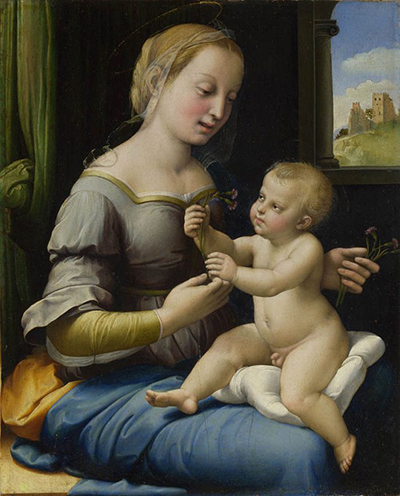The Madonna of the Pinks (La Madonna dei Garofini) has aroused more controversy than most other paintings, particularly as the National Gallery, when the owner the duke of Northumberland decided to sell it, had to prevent the work being exported to the Getty museum in Los Angeles, and to raise around 35 million pounds to acquire it in 2004.
This oil painting painted on a panel made from yew measures just 27.9 cm by 22.4 cm. Some controversy has arisen over the question as to whether the work is actually by Raphael. In 1853 the painting was acquired from the Italian artist, Vincenzo Cumuccini, by Algeron, 4th Duke of Northumberland (along with the rest of the collection). In 1860 John David Passavant, a Raphael scholar, thought it to be a copy. It therefore remained being described as such in Alnwick Castle (the Duke of Northumberland's seat) until 1991 when the curator, Nicholas Penny, from the National Gallery, persuaded the duke to let experts examine the work to see if it was, instead, a real Raphael.
Nicholas Penny had noticed a pedimento (sign of alteration) running through the tower and thought such a pedimento would be unlikely in any copy. After much examination using the latest infrared technology revealing what was underneath the painting's surface layer, an underdrawing was revealed closely resembling that found in Raphael's Small Cowper Madonna. Pigments were identified to those the painter had used in other works. Some critics were still not convinced like Brian Sewell who thought the work 'awkward and hesitant' and Desiderio Z Caruzzi who cited incomplete analyis. The painting is now, however, generally accepted as being by Raphael both by the scientific evidence and by the fact that the underdrawing revealed is of such high quality.
The painting of a Madonna and Child is based on a composition by Leonardo da Vinci (who was 31 years older than Raphael) called the Benois Madonna. In Raphael's painting the Madonna gives the child some pink carnations which symbolize marriage representing the Madonna both as Christ's mother and as his bride. The flowers are supposed to represent a premonition of the last days of Christ known as Christ's Passion. The carnation (flower of God) is said to have first appeared at the Crucifixion when the Virgin wept. Although the theme of Madonna and Child is commonplace Raphael displays tender emotion in the relationship between mother and son.
Through the bedchamber window the viewer can see a sunny landscape of blue and green and a ruined tower symbolising the fall of paganism. The colours are repeated in the clothes of the Virgin and this seems to have been entirely Raphael's idea. The painting was one of the last Madonnas that Raphael composed in Florence before he moved to Rome. The original patron is not definitively known though some scholars suggest, from evidence given in an inventory made in the 1850s, that it may have been the Perugian woman, Maddalena degli Oddi, after she became a nun. Today it is a very popular painting in the National Gallery having been largely disregarded in its previous home.




